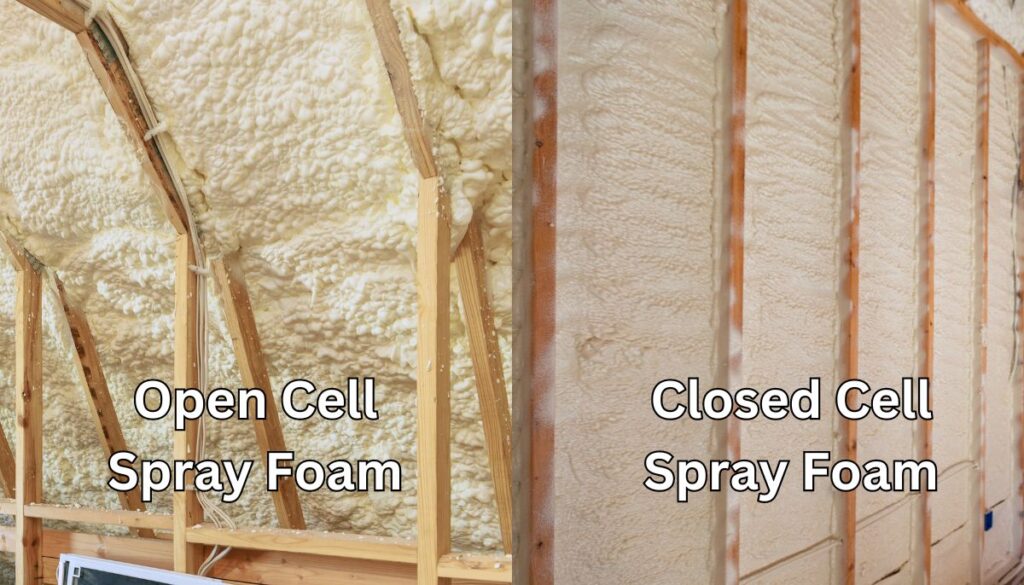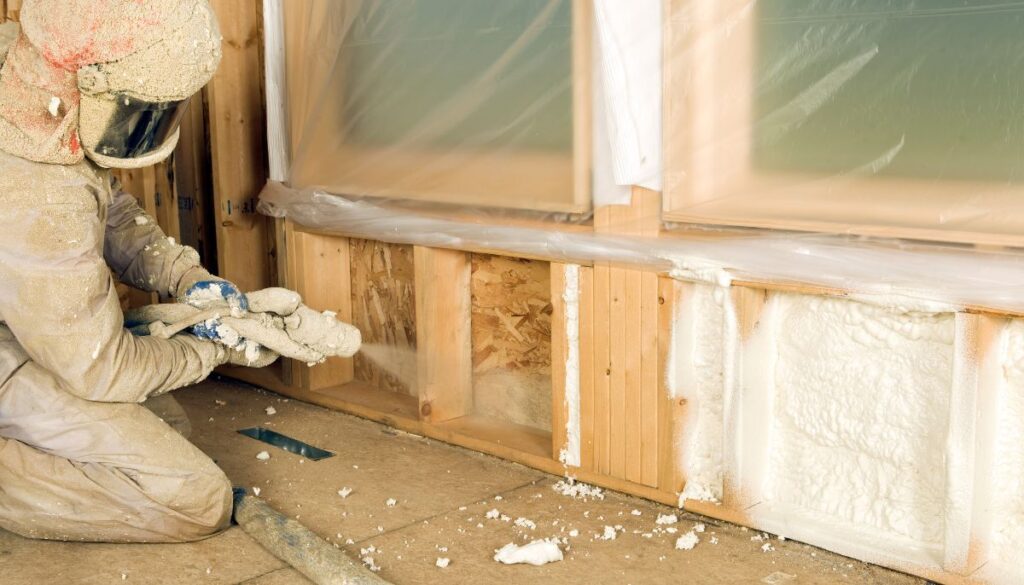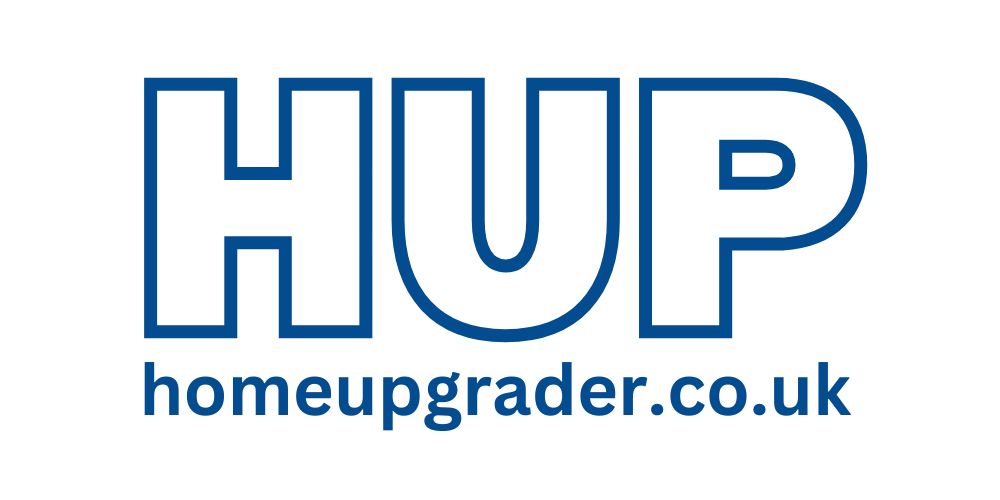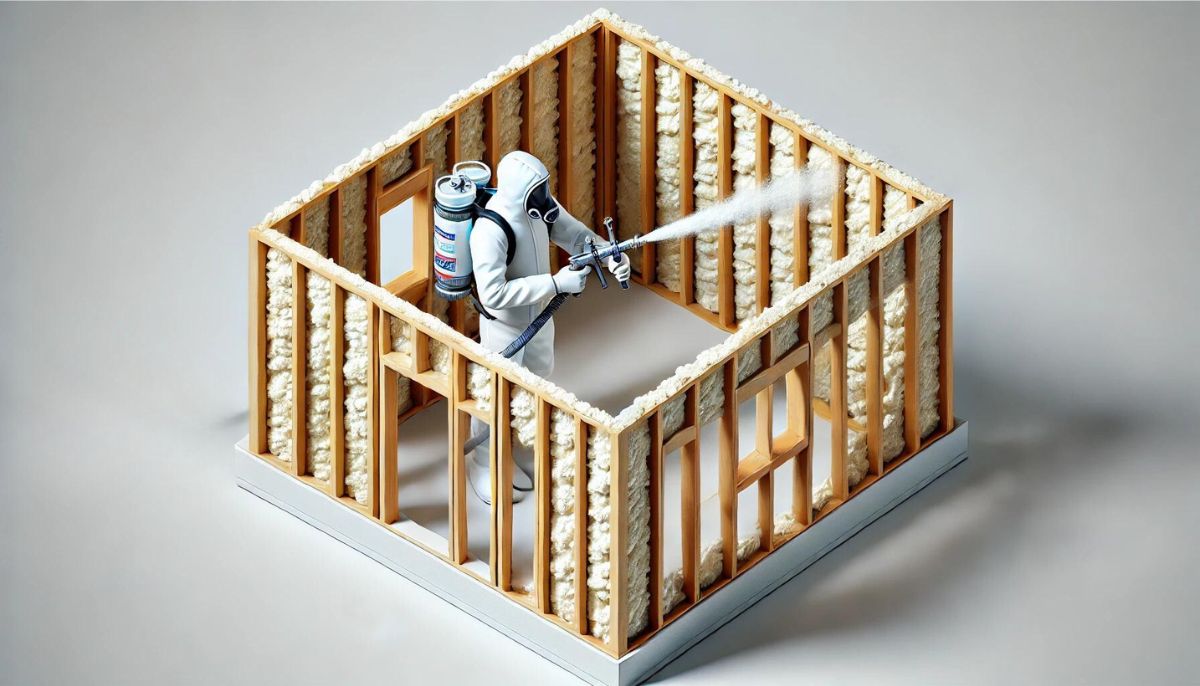Spray foam insulation continues to be a hot topic. With a history of dodgy installations, and stories of mortgage woe, it’s fast becoming the bogeyman of the eco revolution.
The House of Commons library has even written a paper about it.
But as an interested (and quite cynical) reader, I’ve found it quite difficult to get a true picture of the pros and cons. I wanted to dig a bit deeper – does spray foam ruin your home? Or do the people selling spray foam ruin your home?
Or.. is it fine?
The types of spray foam insulation
There are two types of spray foam insulation: closed cell and open cell. Closed cell is denser and a better insulator. Open cell is more breathable, and easy to cut to size once applied.

Both of them are applied using a big hose to walls, roofs, wherever you want a layer of insulation. It’s a technical job with lots of potential for error. You’ll have seen it advertised as it’s an attractive job for tradespeople – fast, and high value.
Does spray foam insulation work?
Spray foam works extremely well as an insulator. It is a comparable insulator to its two main rivals: rock wool and rigid insulation board. You can see from their R-values per 100mm:
- Rock Wool: 2.3 R-value
- Rigid Insulation Board (PIR): 4.6 R-value
- Open Cell Spray Foam Insulation: 3.5 R-value
- Closed Cell Spray Foam Insulation: 2.5 R-value
Spray foam has the added benefit of remaining airtight. Insulation statistics are often misleading. Rigid insulation board, for instance, has excellent insulation properties. However, when cut into shape by human beings, there are inevitably little gaps at the edge for heat to sneak out. Not so with spray foam.
In terms of installation, spray foam is a winner, too. You can do the whole house in a day. And, while it will be a bit more expensive than other methods, you’ll still usually get change out of £3000.
So let’s all switch to spray foam, right? Well…
Mortgage issues with spray foam
Mortgage companies hate spray foam. They will regularly decline mortgage applications if they find spray foam in the property.
This is not a myth. The forums are full of this happening. Nationwide, the UK’s biggest lender, are explicit about their requirements.
‘If spray foam insulation has been fitted in the wall voids of the property, then the valuer will decline the property.
The valuer will decline the property at first, where spray foam has been installed in the rafters, frame, and/or underfloor structure. However, we’ll reconsider with evidence of either:
Confirmation the installation of the foam is in accordance with the manufacturer’s recommendations, and
- The full pre-survey suitability report including details of the materials/isolating card
- The condensation risk assessment
- Evidence of BBA certification
- The warranty/guarantee provided of the installation and insulation. This warranty must be transferable upon sale of the property to the new owners.
Or
A Chartered Building Survey (FRICS or MRICS qualified) should be instructed to undertake an invasive inspection. They’ll need to report on the frame integrity. Where it requires remediation or foam removal work, you will need to include an estimated cost.’
If you’re thinking about getting spray foam installed now, that’s simple advice to follow. But what does this mean if you’re trying to buy (or sell) a house with spray foam in it? Maybe you get lucky, and the original installation was logged with every i dotted and T crossed. Builders love admin, don’t they?
Failing that, you can get it checked by a surveyor, or get it removed. These will both be costs in the £1000s. And it may be very difficult if the spray foam is in the walls. But if it needs doing, it needs doing, and there are plenty of companies out there who can help.
But what do mortgage companies have against spray foam anyway?
Structural issues with spray foam insulation
Spray foam can have multiple damaging effects on your home:
- Damp. Spray foam can trap moisture in the wrong places, leaving structural components (such as rafters) to rot. Closed cell spray foam in particular is not breathable, so any moisture which gets between the spray foam and the roof membrane could be stuck there. If a surveyor can’t see your rafters, that’s a big alarm bell – anything could be happening beneath the surface. Spray foam is often used in loft conversions, where the foam is subsequently covered up by plasterboard. Again, this ‘hidden issue’ makes mortgage companies very uncomfortable.
- Roof tiles. Spray foam is sometimes used as a ‘glue’ to hold old roof tiles together from beneath, as a cheaper option to re-roofing. If you then need to remove the spray foam to get a mortgage, this essentially means replacing the whole roof. Hugely expensive.
- Electrical cables. Some spray foam can eat through the plastic around electrical cables, and cause the electrics to trip, requiring costly repairs. Easily avoided by adding extra protection to the cables, but a pain if it’s already happening under the surface.
You often read that spray foam insulation needs to be ‘properly installed’, but what does that actually mean? It’s usually skipped over, and it varies by product, but you can read the manufacturer’s guides to give you an idea.
The main factors are: mix, temperature, surface preparation, and application.
The mix is important as spray foam insulation usually comes in two parts: Isocyanate (the ‘A’ component) and Resin (‘B’). The installer mixes these, and of course this mix can be incorrect .
The temperature is crucial, and guidelines have strict temperature parameters, within which the chemicals must be kept. The components often need to be pre-heated to achieve their desired range.
The surfaces to which spray foam is applied need to be clean and dry. And, of course, any warm or cold surfaces can affect the mix.
The application of spray foam, carried out by an installer with a hose and a hazmat suit, needs to be precise. Each pass of the spray foam cannot exceed a certain thickness, otherwise excess heat can build up. While all the gaps should be sealed up, it’s also important not to obscure structural elements such as rafters – this is often a reason for failed mortgage valuations.

Get any of these steps wrong, and the spray foam may fail the standards. This is tricky (especially the temperature control) even for trained installers, as you can see from the Spray Foam Installer forums (yes, they exist). Clearly, not a DIY job.
Summary: is spray foam insulation worth it?
It’s hard to recommend getting spray foam insulation, even though in most cases it’s probably fine. Better than fine, actually. Even so, the gains in insulation performance are not going to outweigh any remedial work (if you have to do them).
If you’re buying a house and it has spray foam, what then? Well, some people would say walk away, which is reasonable advice. However, you can see from the Nationwide guidance above that mortgages can be granted after an ‘invasive inspection’ by a surveyor. Another approach would be to ask the seller to cover this cost.



